Visiting the European Motor Show in Brussels
by Dirk De Paepe
A different approach to a car show.
1902 was the first year of the Motor Show in Brussels.
It has been a big event in our country as far as my earliest memories go (and far beyond that). I remember the black and white TV reports, showing the new cars of the late fifties. I still treasure the remembrance of visiting the show as a little boy in the early sixties, together with my parents and my brother, exchanging thoughts about what would be our next car. I also remember visiting with the last class of high school, around 1970, and later a few times to get information for my own next car. The event gets much attention in the Belgian media and provokes lots of traffic jams in the area.
This year, I didn’t visit the show because I was into buying a new car. I visited it because, being such a big event for so many people, I find it an inspirational place to take pictures. Yet this isn’t a typical Motor Show report, with lots of new car models in the lead role. I even carefully avoided to make it too obvious what cars are in the picture. Instead, I wanted to show the visitors. Perhaps you remember from earlier articles of mine, that “people’s behavior” is my favorite subject. Therefor I like to visit places where people behave in a typical, specific or remarkable way.
It always strikes me how people behave in a particular way, when visiting a car show. Well, that’s precisely what I wanted to picture. I’m looking for scenes that stimulate my imagination, that make me wonder what people feel – how they experience the event. I fantasize about their mutual relationships, what there intentions might be, what makes them act as they do, etc…
I hope it’s not too big a disappointment, having to miss all those car pictures, but I’m sure, if you wanna see those typical motor show shots, that you’ll find it not difficult at all to get tons of them on the internet. 🙂
First the picture
I invite you to first look at each picture, before reading its title and story. With the title, I try to nail the essence of my personal thoughts about the scene and my intent with the picture. If the title is not immediately clear, the short story will clarify, I hope. Like I said, what I write is just my personal thoughts that go with the scene. I’m not at all saying that those thoughts are all the absolute truth. They’re just the reflections of how my imagination was stimulated by the scene. They are the reason why I took the picture.
It’s clear that I have no part in the scene itself. I’m merely observing and registering. My part is limited to the scene selection, viewpoint, timing and framing. So I didn’t have any power over the light neither. Many consider the light the most essential element in photography. I tend to not share that opinion completely. I believe the most important power of photography is its ability to freeze moments out of reality, giving that moment “a life of its own”. IMO no other art form can do this as easily as photography does. That’s why, again IMO, registering typical and remarkable scenes out of human life, is one of the main “tasks” of photography. Of course, if the light conditions are optimal, that’s wonderful. But I find being there at the right place and the right moment, to be even more important. I believe, when registering, the occurrence outweighs the light.
So each picture is a small story on itself. But let me be clear. I’m not proclaiming that my stories are the absolute truth. Indeed, some of what I describe actually happened. On the other hand, much of it is my personal interpretation of the scene. Which is truth and which is fantasy is completely irrelevant, because I have no journalistic aspirations with this article, not in the least. It’s merely a painting of general human behavior, feelings, reflections. Anyway, I always try to interpret the scene in a way, that very well could have been what actually happened. My goal is to make viewers reflect on human behavior, and thus to induce a better understanding. You are very welcome to interpret those scenes in your personal, very different way. I even strongly invite you to do so. That’s why I prefer the title to be put under the picture, instead of above – like Claude Debussy did with his preludes for piano, putting the title at the end of each score, inviting us to listen and have our own fantasy first, and only afterwards suggesting the subject.
Zeiss Loxia and Batis
When registering, one is first looking for a place that offers opportunities. Then it’s a matter of feeling: moving oneself to a favorable viewpoint, and acting as fast as possible – which sometimes requires cropping/reframing afterwards in pp. To be able to act very fast, is why I often apply zone focusing (with lenses up to 50mm focal length). The Loxia MF lenses are absolutely perfect for this application, IMO – great for zone focusing, thanks to their straightforward DOF scale and fantastic to manually focus very fast thanks to their super smooth focusing ring. Although, for these series, I also used the Zeiss Batis 85 – my first AF lens. I thought it could make sense to have AF in a tele, since its DOF is a lot smaller by definition, which significantly reduces the possibilities for zone focusing. But I have to say that, as far as now, I’m a bit disappointed in AF. I’m just having a hard time, handing over the decision to the camera. And I can’t say I’m experiencing that much “extra comfort” from the AF, compared to using a MF 85mm. It’s different, but on the whole… it’s not that spectacularly focusing faster or better (sometimes the focusing is worse than when performed manually).
Like I said, the other lenses I used were both Loxia’s, 50 and 35 (mainly the 50 here). Those Loxia’s are IMO simply perfect for the A7RII. When Zeiss will make a Loxia tele, I guess I’ll sell the bulkier Batis and replace it with yet another Loxia. (BTW, while writing this, my Loxia 21mm just arrived. The first thing that struck me is that it’s absolutely very compact for a 2.8/21. And I’m also immediately blown away by its IQ.)
OK, enough introduction. Let’s go to the pictures. I hope you’ll enjoy.
Sheer Delight
American cars with big V8 engines are still pretty exotic in Belgium. To experience this is a real joy for many guys, regardless of their age – even if it’s only in a static way and for just a few minutes… at the motor show.
–
Although already of very respectable age, this man’s mind is in another place. He’s not considering how much he can use this car – how much convenience he can get from it in his professional activity. Instead he’s dreaming about how much he wànts this car – how much pleasure he can get from it for his leisure passion. At the motor show, the dreaming is served for all ages.
–
I admire this stylish lady. She proves that women can age beautifully, while still remaining completely natural. I noticed how she came to the show, watching and judging the cars. She wasn’t carrying a paper bag to gather brochures of so many different brands. She was only holding one catalog, the show catalog. A representative was explaining her the specs of a specific model. She was eager for the information. But I think that not all new, modern car features were immediately clear to her, which made her unsure as yet about what to decide. It was the duality of her motivation on the one hand and dubiety on the other that made me wanna take her picture.
–
This remarkable lady was really into a new car. A few things stroke me. She was on her own. She was visiting the booth of a pretty exclusive brand. She was getting very specific information from this representative for her next personal car. She was connecting very targeted and without any restraint with this young(er) man. I even wonder if he was not taken slightly discomfited by her pretty assertive approach, not looking towards her, while she was absolutely focusing on him. It made me wonder about her place on the social ladder. For sure, she made herself a great career. She seemed to be at the pinnacle of her performance ability – in the stage of her life that she’s 100% self confident, going straight to her goal, fully aware of her exceptional competence. Scenes like this make me realize that we live in an absolute wonderful society in Belgium, where women can make a difference.
–
Fathers teach their sons. That’s how we believe it to be. But at a given age, this changes, although we usually don’t dwell on it. The son, that I pictured here, wanted to visit the big Motor Show, and has invited his father with him, as a kind of treat. Of course he remembers, as if it were yesterday, how his father took him to the same show as a little boy, more than four decades ago, giving him the best day of his life. Today, he is pleased to return the favor – so happy to demonstrate the marvels of modern car technology, even though his father is at that stage of his life where cars are merely a means of transportation and a lot less thrilling than they used to be. In this scene, the son demonstrates how the lid of this heavy SUV can simply be closed by pushing the button. It’s obvious that the father didn’t know this feature yet. He’s clearly watching in fascination, as if a kind of small miracle is about to happen. I absolutely love this scene. It’s probably my favorite picture of this series. The profound love between father and son screams from it and really moves me.
–
This man has made it. He’s getting a special VIP treatment. He’s trying out the flagship of a leading brand, a state-of-the-art sports coupé, with all thinkable features and comfort and stunning performance. But merely getting in and out apparently is kind of an ordeal. Although in great shape, training his body on a regular basis, it took quite some time to figure out how to get back on his feet. I took several shots of him – one even showing him with the tongue a bit between his teeth, thinking of the best way to accomplish this task. I even thought of putting those pics in a series of five, for better illustration, but finally reckoned that this one shows a perfect synthesis. It illustrates the required body strength and control. It proves how, once found out the right way to go, one can “dismount” in complete harmony with the lines of the car – as long as one is kind of an athlete. BTW, next picture shows his collaborator (who takes profit from his “boss” to enjoy many exclusive cars on the show), having more difficulties.
–
With a less well-trained body and being not that limber as his boss, this guy has great trouble getting in the cockpit. His body just seems much too colossal to ever succeed. At this stage, I almost expect him to be sucked in with a loud “pwah!”, by a big vacuum-cleaner-like force in the car. Well,… he finally got in alright, but the getting back out was just problematic. He performed like a dozen different stages, taking a good twenty seconds to complete the process in the most inelegant way thinkable, before finally getting back on his feet with a big smile on his face – just to conceal the shame of his fumbling. This car clearly is worth every penny – a show within the show.
–
Years ago the girls, working at the booths of a motor show, had kind of a pinup role. Nowadays, there are still (young) women working, but they do a terrific job in informing the visitor. All of them, as far as I could observe, were perfectly multilingual (in Brussels that means at least Dutch, French and English) and were professional in their approach. The young lady in this picture is clearly loving what she does. I spoke to her afterwards, showing her this photo and asking if I should delete it. Of course I could keep it. But the way she communicated with me in an open, friendly and welcome way (like she did with all other people) was simply telling me that she absolutely loves working at the motor show. And she does a great job indeed!
–
I took four shots of her, since she gave me so many nice poses. When she realized that I was really shooting her, she stopped, looked at me and said (with a big smile): “You are taking my picture, or what?!”. I answered: “Well, I find girls much more beautiful than cars.” “Oh”, she replied with an even bigger smile, “a normal guy!” I can tell you, she is a very beautiful girl, playing a nice role in this scene, kind of how a movie star often has to play expressive scenes. What is the value of a car anyway, when you can’t properly check you makeup…! Her brother, sitting in the passenger seat, is just checking the dashboard. The representative, standing next to her, doesn’t seem to get the relevance of her test and is just patient.
–
When an exhibitor places a barrier around a car, he indicates that this is a very expensive and exclusive model. He expects the visitor to be that tactful, to stay behind the barrier, unless he is invited to approach. The two guys in this scene visit the show together, since they work together (like is the case with many male duo’s visiting a motor show). One is the boss, the other a privileged employee. The employee feels the need to prove his initiative and dynamism to his boss, by stepping over the barrier and elucidate some technical specs of this exceptional automobile. The boss absolutely keeps his reservation, being able to get all the information that he wants, from the place where he is expected to be. In a very controlled and subdued way, he’s perfectly mastering every situation.
–
This male duo is young friends, and are staying well behind the barrier. They are reading the specs of a Formula 1 car. And it’s not just any bolide, it’s the one that became World Champion in both the 2014 and 2015 seasons. It’s a car that, for 200% sure, they will never drive. Still they are absolutely fascinated about those specs. Totally unrealistic of course, but still the ultimate car fantasy for sure.
–
Yet another duo of friends. But those are apparently really into the technique. I guess they know what they’re looking at and that it’s not just an act for show. Future customizers?
–
I guess about half of the visitors is taking pictures. Many with a camera, even more with their smartphones. Those two cars are in an enclosed environment. I didn’t see how this young man was able to enter “the premises”, but I could see him perform the “I was here” act.
–
The exhibitors spare no effort to draw the visitor’s attention to their booth. Here, they performed a quite impressive light show at the ceiling. This young man is clearly loving it.
–
Some visitors have a double purpose: watch and be watched. This young lady drew a lot of attention.
–
Those booth workers, both male and female, have different assignments: informing the visitors and from time to time cleaning up the cars, wiping away the dust and possible finger prints. Like I said, those jobs are done by man and women alike – and I shot them both. But who can blame me that I selected this picture as the most beautiful one?! BTW, again, the professionalism of those workers is remarkable. I was very obviously aiming my camera at here for about maybe a minute to get the right frame. But this didn’t change her attitude or her facial expression one single bit. All the time she just kept on cleaning, just as if I wasn’t there, not specifically posing, but giving me all the time I wanted for my shot! Indeed, the exhibitors still engage beautiful girls, but they are so much more than just looking good.
–
I noticed this scene, because, although this is one of the smallest cars of the show, it brought the biggest smile on people’s faces – like if it made them realize that it’s the feel good factor that matters the most. This girl clearly enjoyed this particular one a lot. So I wanted to catch her happy face in the rearview mirror. But her face immediately changed in a kind of wondering expression. I didn’t notice that her boyfriend was in fact trying to get a beautiful picture from his love, sitting in the driver’s seat of her dream car. He was waiting for me to leave, because he didn’t want me in his picture. I, from my part, unaware of his presence, was waiting for her happy face again to appear in the mirror. After some five seconds, she understood what her friend was referring to. She looked in the mirror and gave me a beautiful smile. Only at that moment, I understood what was going on, noticing (part of) her boyfriend with his camera in the very corner of my frame, so I came half a step closer. I pushed the button and thanked them both for their open and welcoming spirit. I believe the boy took his shot ten seconds after mine.
–
This is not a typical motor show picture, but rather one that shows our present world. Since Bataclan, also the Belgian government pickets protection at every event where lots of people gather. This is what we see today, and it’s not gonna change any time soon. The shot was taken, while standing in the cue at the cloakroom, just before getting back home.
See more on flickr
You can get more technical details about these pictures, via the exif data, that goes with them on my flickr pages . I gathered all these pictures in HR in a dedicated album, with the obvious title “Visiting The European Motor Show Brussels 2016” (https://www.flickr.com/photos/keepnitgood/albums/72157663992622111), where there will also be black and white versions of them.
And I’d like to conclude with thanking Steve and Brandon for keeping this unique site online. I insist on mentioning with every article, that the opportunity they give us, by publishing our articles, is flat-out fantastic. We have a really great community here, thanks to their effort. And having been in the publishing business myself for over 3 decades, I know that this is far from obvious. I love to read the articles of so many of you, I also hope you liked mine.
Dirk

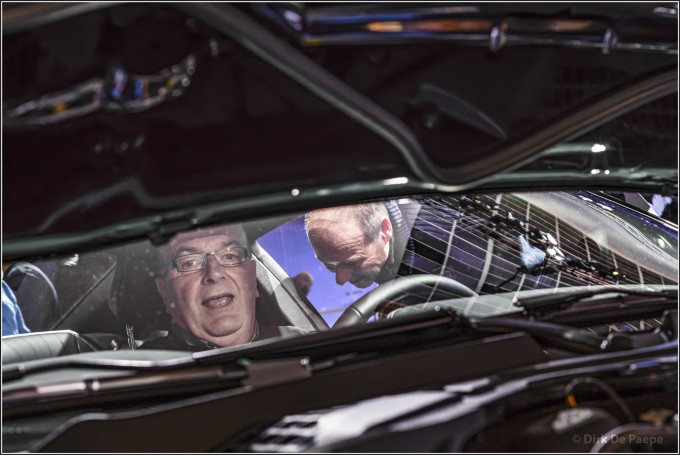
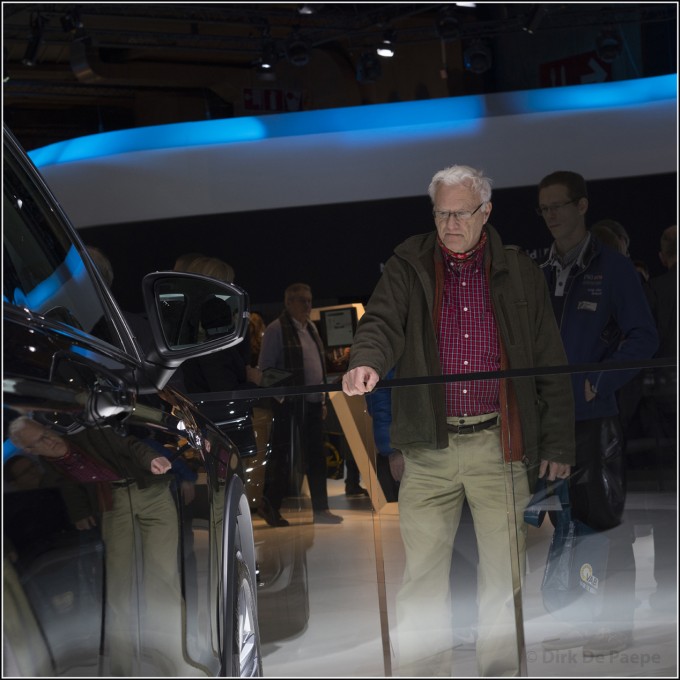
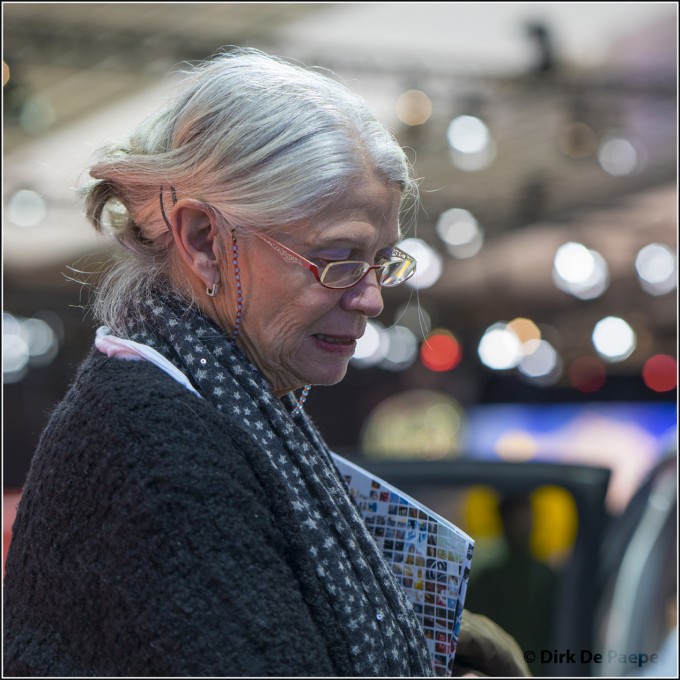
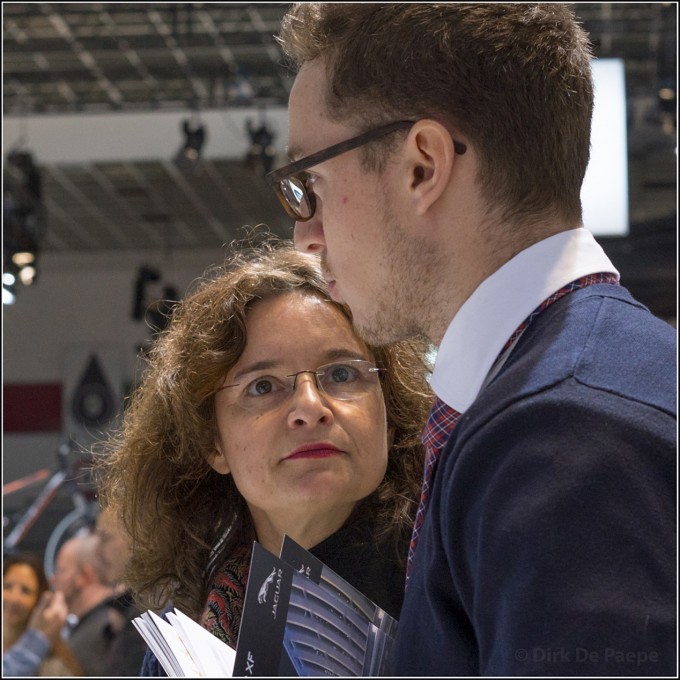
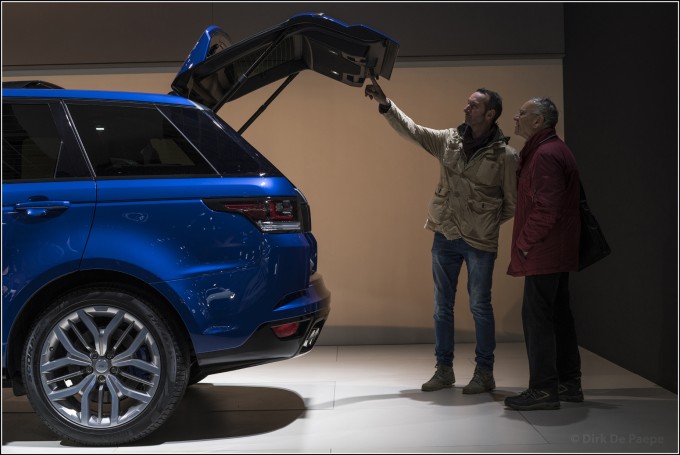
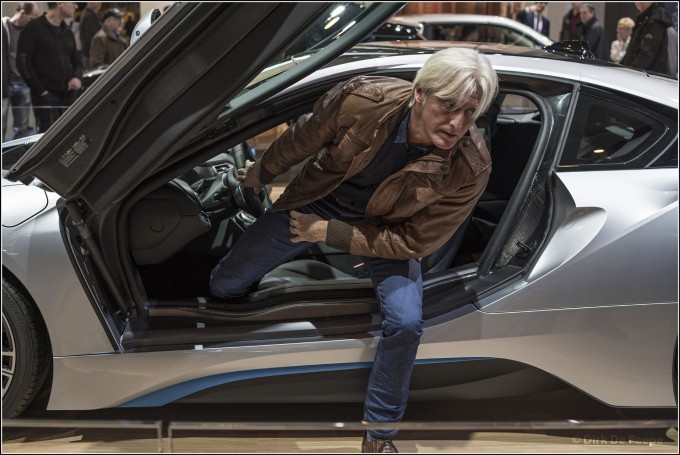
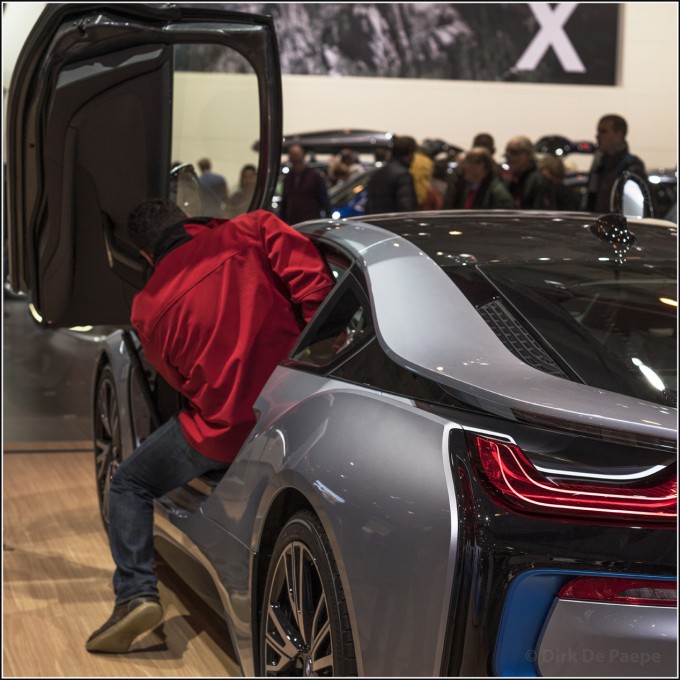
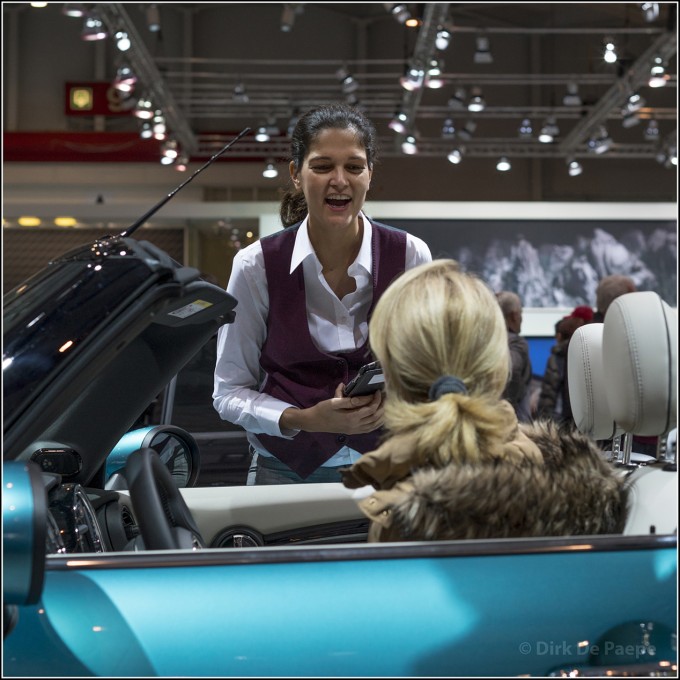
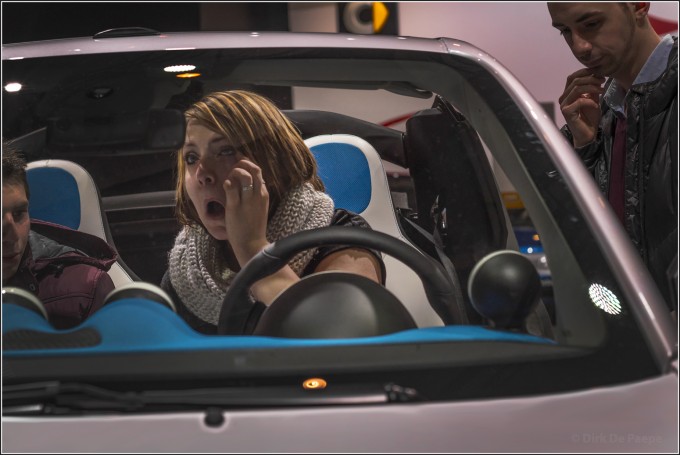
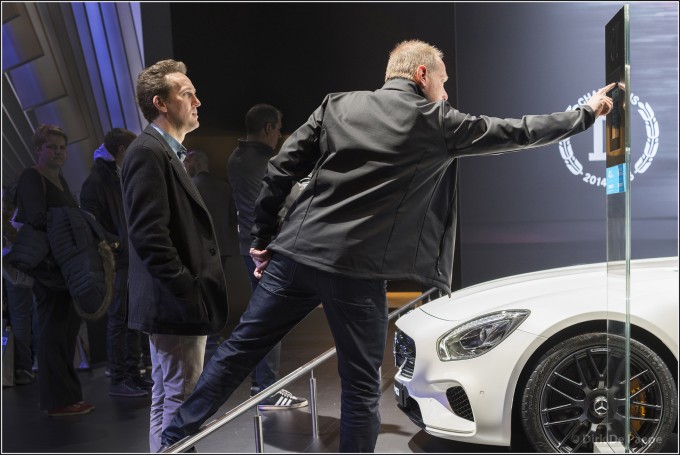
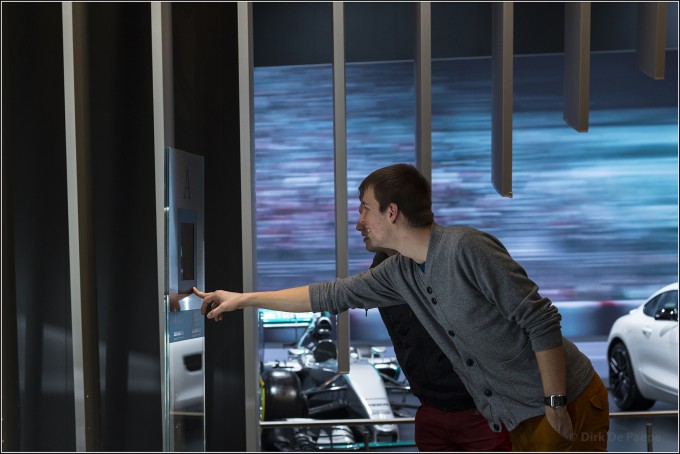
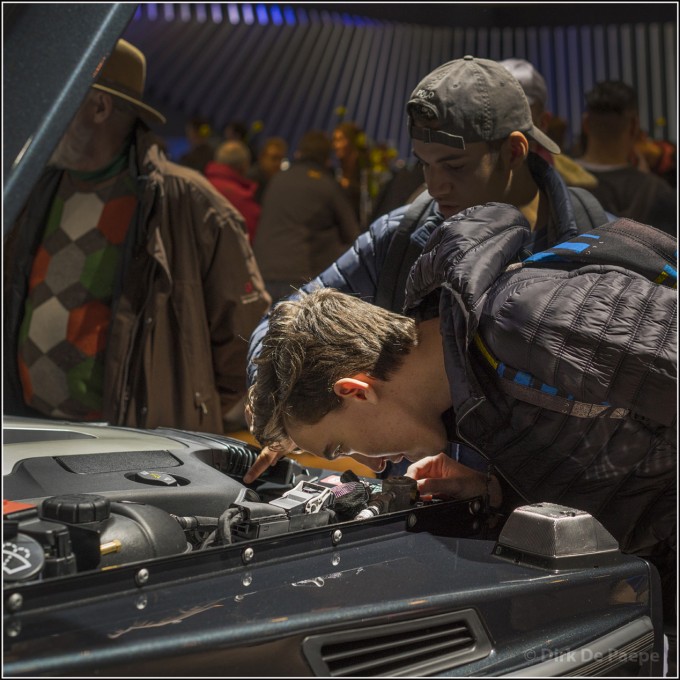
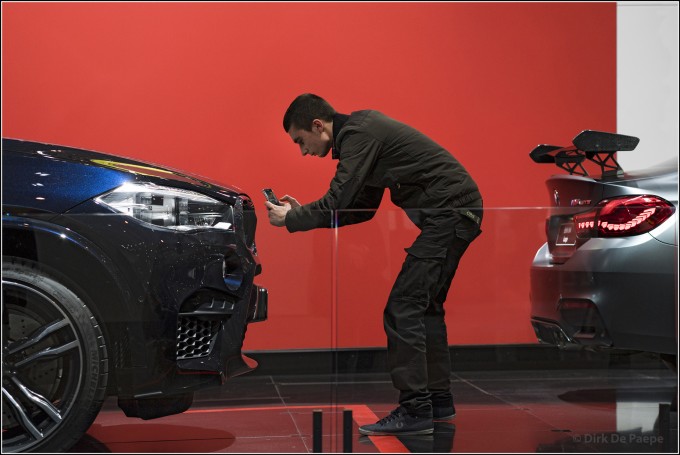
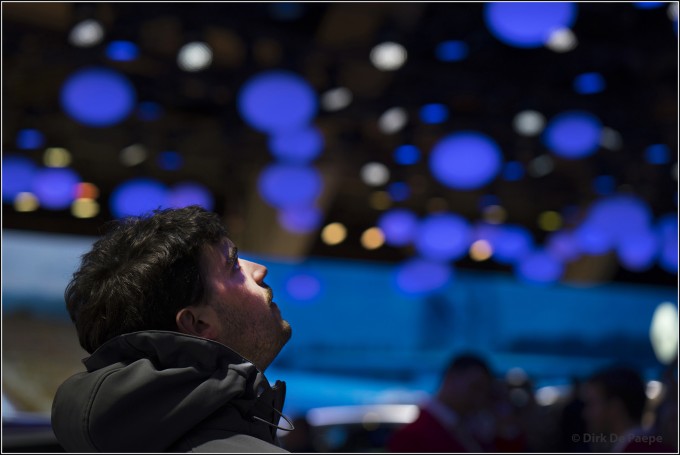
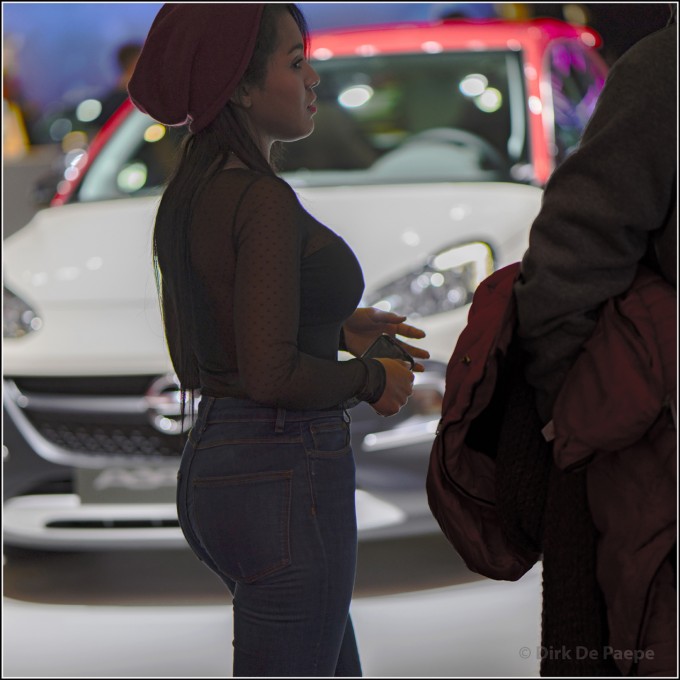
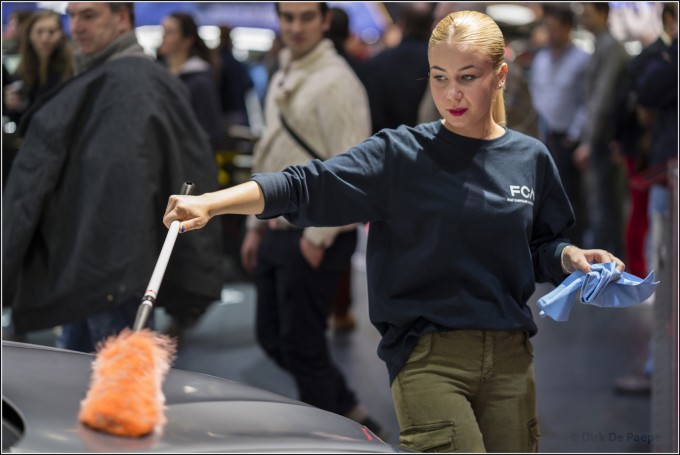
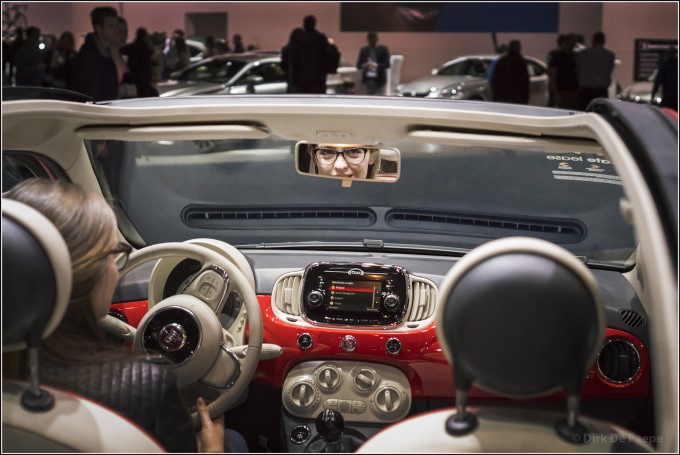
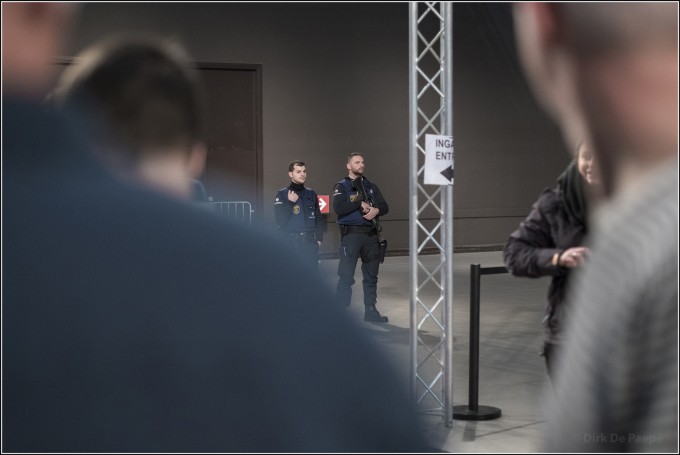

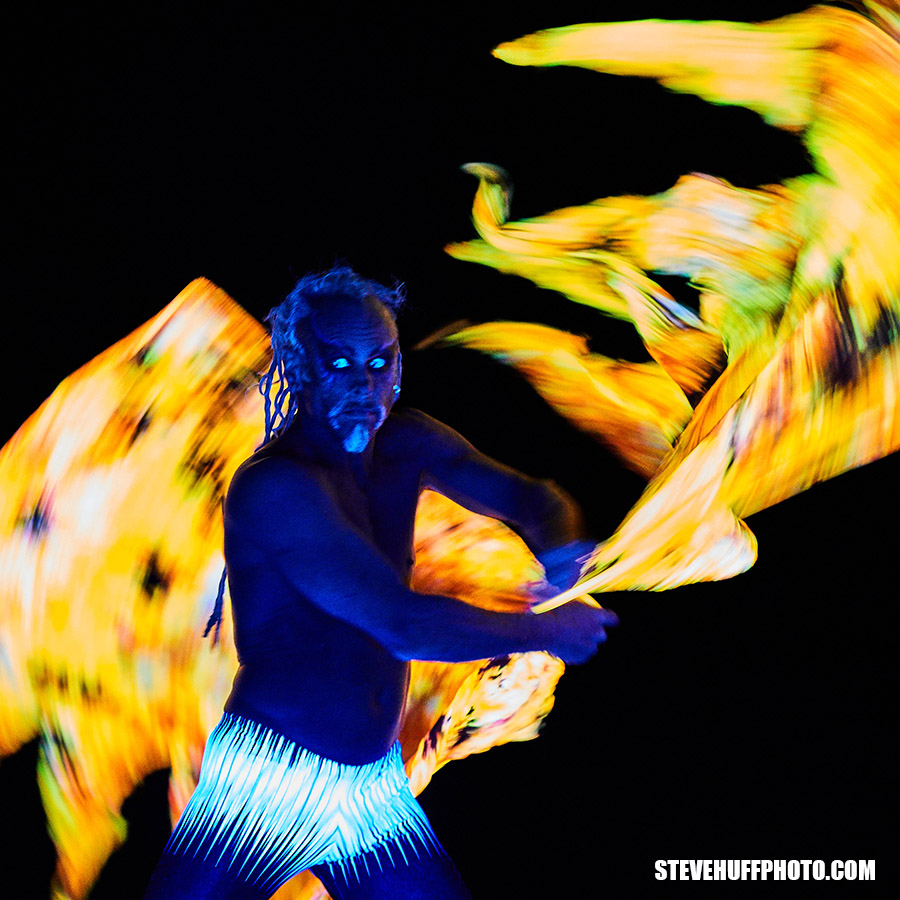

Hi Dirk
Great set of photos. As stated in the post, the commentaries are there if you want to check what went through Dirk’s mind as he took the shots. You could, of course choose NOT to read it.
I simply love the dynamics in the pictures, and feel a part of the show. Well done.
Dirk, this is good work, but I am going to challenge these statements: “It’s clear that I have no part in the scene itself. I’m merely observing and registering. My part is limited to the scene selection, viewpoint, timing and framing”.
These ideas are self-contradictory. You had everything to do with the scene if you chose it, framed it, and photographed it. The scenes that are presented in your photographs are very much your creation. The people milling around the cars are like actors awaiting your direction. When they are in the right position, they become a part of your drama and vision, and you capture it, a brief moment in the play of life that is your work.
As a separate topic, I really dislike giving a title or commentary to each photograph. It’s completely unnecessary. A photograph begins as your work, but when it is read by a viewer, it becomes that person’s photograph to interpret, to understand. Please don’t tell the viewer what to see. It would be like a literary author writing a separate, detailed accompaniment to instruct the reader on how to read his novel. Or a musician instructing the audience on what his music means. Let the work speak for itself, my friend.
Thanks a lot for your appreciation, Tony.
1) What I meant was that I didn’t tell the people what to do. I had no part in the action. Of course all the rest was indeed my creation. By choosing and freezing a moment, indeed I “create a new scene”. The importance is that the people act absolutely natural, which I believe to be the most interesting way to shoot people.
2) You have every right to dislike my title and story. But I invited you to first look at the pictures and to interprete in your very own, very different way. If that’s what you prefer, why did you read further anyway? I was very anxious to know your interpretation of the scene. So why didn’t you tell me?
3) Still I believe that I have every right to add title and story. This is not exceptional in other art forms. Ever heard of program music? There are so many great classical works, throughout all centuries, that tell a very specific story. I’ll just give you a few well known examples: Vivaldi’s The Four Seasons, Haydn’s Die Schöpfung, Berlioz’s Symphonie Fantastique, Smetana’s The Moldau, Ravel’s Jeux d’eau, Messiaen’s Catalogue des Oiseaux, etc. (This could be an endless list.) And BTW, each song has lyrics, many of them telling a very specific story… And comic books also combine text and images in one work. So I think there’s no difference when I combine text and images in one article.
Dirk, thanks for your response. I believe the best title for the majority of art is “Untitled” and let the viewer read a photograph. Maybe some naming, like “Mr. Brown, CEO of Megacorp” is fine, or “A view of the Seine at Asnieres”. The titles being placed so close to your photos, it’s impossible not to see them and be influenced. But, for example, “still dreaming” could be “my god, ridiculous price”. “Athletism” could be “not enough room”, and so on. Cordially,
Dear Tony, I believe the way to gay with the articles, published on this site, is to click on the pictures to enlarge them. Steve writes time after time that this is the only way to see the pics in good quality. And indeed, also my pictures have much better dynamics and detail after clicking. It’s only then that the facial expression of the people is clear to see. In “The Changing of the Guard” for instance, the mimic of the father is essential. Very clear when enlarged, not really visible when not.
And you know what, when enlarged, the title and all the text is no longer displayed. So your problem wouldn’t have been the matter.
BTW thanks for communicating me “your titles”. It’s only an enriching of the content of the images.
Two corrections. It’s of couse “the way to go” instead of “gay” and “mimic” must be “facial expression”.
Are you be able to read the minds of others; to describe their thoughts and feelings with such assurance? You can not know the minds of strangers and presume and project their thoughts and feelings. People are more diverse and complex than one can imagine, let the viewer interpret the images (with no less or greater accuracy).
Dear Nigel,
I really don’t understand why you wrote this comment. I think you need to read the article, because I specifically indicated that what I wrote was only parly what actually happened and largely a reflection of my imagination.
best “street Photos ” yet !
Wow, John. Thanks you so much for this.
Love the photo of the girl with the duster ! Great write up thanks.
Thanks, Fergus. I’m already thinking of a next article… 🙂
Hi Dirk, very nice texts, the ideas are great. I am attending car shows regularly, sadly i often can’t muster the courage to snap people .. it’s a bit out of my comfort zone.
But i wanted to write about something else – the loxia 35 f2 .. What is your take on this lens and its .. um .. character == massive coma on any highlights wide open (it’s by design – see verybiglobo blog where’s the explanation), how do you ‘use’ it – or, do you simply avoid the situation when this kind of ‘issue’ happens?
Thanks, Zak, for your comment.
About the Loxia, 2/35, since its release it quickly became my most used lens. I love it to peaces. I never avoid anything, when shooting with it.
BTW, Steve has been so kind to publish an article that I wrote about this lens. It can tell you much more than I can write in this reply. Maybe it’s a good idea to read it. Here’s the address: http://www.stevehuffphoto.com/2015/02/16/testing-the-zeiss-loxia-235-biogon-the-future-of-manual-focusing-by-dirk-de-paepe/
Cheers!
superb reportage-style feature, clearly showing the quality of tose lenses. particularly the bokeh
Thanks a lot, Christian.
Love the photos and the stories. Thank you. The BMW i8 isn’t that tricky to get into and out of once you know the technique!
Thanks, BVH. Indeed, I hear it’s a matter of habbit to get in and out this kind of cars. (I wouldn’t know, I never owned a sports car.) But obviously, when not being used to it, one has serious problems. As the pictures show. 🙂
Dirk, another wonderful entry! These shots are fabulous. I’ve only been to one car show in my life. It was located in Fukuoka, Japan. I happened to stumble upon it during a weekend visit to the city in 2014. I’m not a car guy myself, but I enjoyed the thrill that the polished automobiles brought to spectators. Your description of registry and capturing these moments was immediately familiar to me. The Decisive Test and The Essence are my favorites and best illustrate your points IMO. Thanks for sharing!
Thank you so much, Jonathan. It really feels good to be appreciated like that!
Dirk,
Thanks for the write up and images. I enjoy your full reviews you have authored on/for this website. Something I’m trying to figure out is concerning the colors – are they natural (or close to natural) of what the camera produces? Or, are the images de-saturated in post?
A lot of the images appear ‘flat’, or low contrast, with the first one specifically almost appearing closer to that of an HDR.
The above is not a criticism of the images produced. But, since you provided information about the camera + lenses used, I’m more interested in the facts of how you arrived at the final produced images in the article. As you have time, please elaborate on that to some degree for the understanding of how that may be or may not be inherent to the camera and lenses you used.
Thanks and Best Regards,
DMR
Thanks for your reply and appreciation, DMR – Daniel Mark Roberts? – I like to fantasize… 😀
I wrote in this article that I’m having a hard time, handing over the decision to the camera. This was concerning AF versus MF. But the same thing goes for the colors. That’s why I will never go with the out-of-camera colors.
What I want from the camera/lens is to provide all the basic material with which I can do whatever I want. Since my first digital camera, there has always been something left to be desired in this department. The Sony A7R was the first that really satisfied me, that gave me the feeling that I could get whatever I wanted. And with the MKII, this goes even better, easier, faster, with larger headroom, and in even lower light. When I’m looking at OOC shots, taken with the Leica SL, it strikes me how immediately “pleasing” they are, more so than the OOC Sony/Zeiss images. IMO, anybody who wants pleasing colors, without having to do any work in pp – purely from that point of view – the SL would obviously be the better choice. But I am not looking for those kind of colors. On my flickr pages, I also placed B&W versions of the shots of this article, and I believe they work pretty well, because the main element of those photo’s is the character of the featured people: their body language, their facial expression. In those color shots, I think the colors can give extra atmosphere. They are also making the images more realistic, I believe. But the colors for sure may not draw the attention. The lead role is for the people’s expression.
Now the question remains: how do I treat the colors? My main goal is to go for a neutral or very close to neutral spectrum. My technique is to first slide the vibrance to 100 (in RAW converter, Photoshop), “equalize” the colors (this is a lot easier to be done with the vibrance at 100) and then slide back to zero. I particularly watch the grey’s to be grey in this process. One has to be carefull though, because generally in this process the orange and sometimes red will need to be backtuned a bit (maybe typical fort he Sony/Zeiss). This is the only de-saturation that I perform – sometimes maybe a bit further than neutral, because (this is a personal feeling, kind of an expression I want to implement in my pics) people’s skin in our countries is in general rather pale. After all of this, I normally even slightly increase the saturation after this process – not much and not always. So de-saturation is not a general procedure, on the contrary. On the other hand, I do take great care of the greys in the color spectrum, to get a spectrum that first of all is “informative”. I guess that this is why one can think that I de-saturate. “Willing to please” (in an obvious/superficial way) is indeed very low on my priority list. In this way, I guess there is maybe a bit of a tangent with B&W pictures.
In other pictures, for instance taken in Belgian city streets, I sometimes slide the vibration back to under zero, to express the feeling of drabness that I often get in old city streets (like in the shots of one of my recent articles). This can be combined with some extra black (suble dosage needed!) and again, afterwards, some carefully increased saturation.
Now concerning the first picture, this was exceptionally processed to the edge of what I would ever do with it (not of what is possible), with the purpose to also show a vague impression of what’s under the hood of the car. It was kind of an information/feeling matter to me, that essentially contributed to the “story” of the picture.
Finally, there are lots of other finetuning interventions, that I perform – sometimes less, other times really a lot. Those are only changing things ever so slightly – my wife generally doesn’t even notice any difference :-), but I just love to perform them, and I absolutely can notice them! I’m convinced that even very slight nuances exert an influence, in an unconscious way, on how one experiences an image. I trully believe that the post processing is an essential part in the creative process, comparable to what George Martin meant fort The Beatles (producer George Martin is often referred to as “the fifth Beatle”). It takes at least a few articles to cover all those interventions. But I guess that’s all pretty personal. I don’t know if anybody would care for it…
Like I said, the Sony/Zeiss combination is flatout in-cre-di-ble (!!, IMO), when you wanna pp your pictures. I’ve never ended up in a situation where I didn’t get what I wanted. Thàt’s the real value of a camera, IMO: making anything possible…